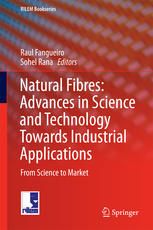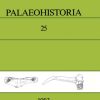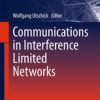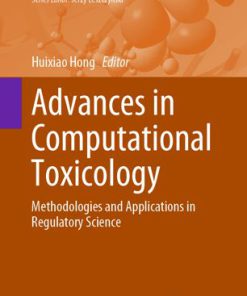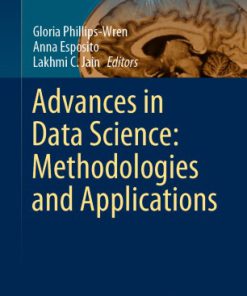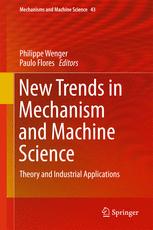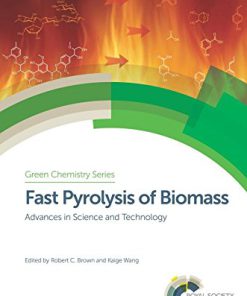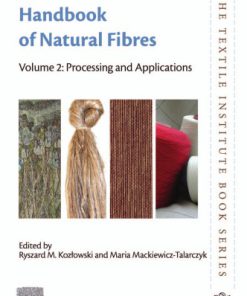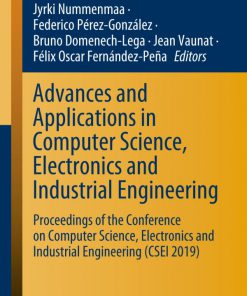Natural Fibres Advances in Science and Technology Towards Industrial Applications 1st Edition by Raul Fangueiro,Sohel Rana 9401775133 9789401775137
$50.00 Original price was: $50.00.$25.00Current price is: $25.00.
Natural Fibres Advances in Science and Technology Towards Industrial Applications 1st Edition by Raul Fangueiro,Sohel Rana – Ebook PDF Instant Download/Delivery:9401775133 ,9789401775137
Full download Natural Fibres Advances in Science and Technology Towards Industrial Applications 1st Edition after payment
Product details
: ISBN 10: 9401775133
ISBN 13: 9789401775137
Author: Raul Fangueiro,Sohel Rana
This book collects selected high quality articles submitted to the 2nd International Conference on Natural Fibers (ICNF2015). A wide range of topics is covered related to various aspects of natural fibres such as agriculture, extraction and processing, surface modification and functionalization, advanced structures, nano fibres, composites and nanocomposites, design and product development, applications, market potential, and environmental impact. Divided into separate sections on these various topics, the book presents the latest high quality research work addressing different approaches and techniques to improve processing, performance, functionalities and cost-effectiveness of natural fibre and natural based products, in order to promote their applications in various advanced technical sectors.
This book is a useful source of information for materials scientists, teachers and students from various disciplines as well as for R& D staff in industries using natural fibre based materials.
Natural Fibres Advances in Science and Technology Towards Industrial Applications 1st Table of contents:
1 Fibre Science: Understanding How It Works and Speculating on Its Future
Abstract
Introduction
The Way Fibres and Fibrous Structures Work
Impact of Emerging Sciences and Technologies in Fibre Science
Speculating on Future Product Development
Conclusions
References
2 Wool in Human Health and Well-Being
Abstract
Introduction
Skin Health
Physical Contact Between Textiles/Garments and Human Skin
Thermal and Moisture Properties
Human Body Odour—Textiles, Clothing, Footwear
Sleep—Bed Clothes, Sleepwear, Bedding
Conclusions
Acknowledgments
References
3 Correlations Between the Physiochemical Characteristics of Plant Fibres and Their Mechanical Prope
Abstract
Introduction
Experimental Procedures
Materials
Chemical Composition of Fibres
Measurement of the Microfibril Angle
Tensile Properties of Fibres
Principal Component Analysis
Results and Discussion
Carbohydrate and Lignin Content of the Plant Fibres
Measurement of the Plant Fibres Microfibril Angle
Tensile Properties of Plant Fibres
Damping Coefficient of Plant Fibres
Determination of the Correlation Between Variables Using Principal Component Analysis
Conclusions
Acknowledgements
References
4 Influence of Stem Morphology and Fibres Stiffness on the Loading Stability of Flax
Abstract
Introduction
Materials and Methods
Results
Stem Height and Fibre Yield
Elementary Fibres Mechanical Properties
Organization and Morphology of the Stems
Correlation Between the Stem Stiffness or Morphology and the Fibre Mechanical Properties
Conclusions
Acknowledgments
References
5 Young’s Modulus of Plant Fibers
Abstract
Introduction
Decrease of the Young’s Modulus as a Function of the Apparent Diameter of the Fiber
Taking into Account the Presence of the Lumen
Assuming the Presence of Another Structural Heterogeneity
Conclusion
References
6 Characterization of Brazil Nut Fibers
Abstract
Introduction
Materials and Methods
Material
Fiber Characterization
Thermogravimetric Analysis (TG)
Scanning Electron Microscopy (SEM)
Wavelength Dispersive X-ray Fluorescence (WDXRF) Analysis
Instrumental Neutron Activation Analysis (INAA)
Results and Discussion
Conclusion
Acknowledgements
References
Part IINew, Functional and NanodimensionalNatural Fibres
7 Brazilian Buriti Palm Fiber (Mauritia flexuosa Mart.)
Abstract
Introduction
Buriti Palm Tree
Collection, Processing and Traditional Employment
Physicochemical Properties and New Employments
Conclusion
Acknowledgments
References
8 Degradation of Dyes Using Plantain Fibers Modified with Nanoparticles
Abstract
Introduction
Plantain Crops in Colombia
Current Applications of Plantain Fibers
Contamination by Chemical Dyes
Methodology
Extraction of Fibers from Plantain Pseudostem
Cationization Process
Functionalization of Fibers
Dye Degradation
Results and Discussion
Fibers Characterization
Dye Degradation
Discussion
Conclusions
References
9 Removal of Crude Oil Using a New Natural Fibre—Calotropis procera
Abstract
Introduction
Experimental Part
Materials
Calotropis procera Fibres
Water Drop Absorption Test
Petroleum
Experimental Planning by Statistical Analysis
Kinetic Study
Results and Discussion
Microstructural Characterization of Calotropis procera Fibre
Characterization of Petroleum
Statistical Analysis by RSM (Response Surface Methodology)
Conclusion
References
10 Amazonian Tururi Palm Fiber Material (Manicaria saccifera Gaertn.)
Abstract
Introduction
The Ubuçu Palm Tree
Collection, Processing and Traditional Employment
Physicochemical Properties and New Employments
Conclusion
Acknowledgments
References
11 Nanoindentation Measurements of Jute/Poly Lactic Acid Composites
Abstract
Overview of Present Situation
Present State of Problems
Experimental Methods
Materials
Pulverization of Jute Fibers to Nanofibers
Preparation of Nanocomposite Films
Testing of Nanocomposite Films
Results and Conclusions
Effect of Milling Condition on Particle Size Reduction of Jute Fibers
Effect of Wet Milling Time on Particle Size Reduction of Jute Fibers
Comparison of Size Measured on Different Techniques
Nanoindentation Measurements
Dynamic Mechanical Analysis
Tensile Testing
Conclusions
References
12 Biomedical Applications of Nanocellulose
Abstract
Introduction
From Cellulose to Nanocellulose: Types of Nanocellulose
Applications in Biomedical Field
Conclusions and Remarks
Acknowledgments
References
Part IIINatural Fibre Reinforced PolymericComposites
13 A Finite Element Analysis to Validate the Rule-of-Mixtures for the Prediction of the Young’s Modu
Abstract
Introduction
Finite Element Analysis (FEA)
Poisson’s Ratio
Conclusions
Acknowledgements
References
14 Effects of Water Ageing on the Mechanical Properties of Flax and Glass Fibre Composites: Degradat
Abstract
Introduction
Materials and Methods
Materials
Resin and Fibres
Chemical Treatment
Vacuum Infusion Processing of Composite Sheets
Methods
Water Ageing Conditions
Water Uptake, Volume and Density Variations
Composites Drying
Viscoelastic Properties Measured by Vibration Analysis
Uniaxial Tensile Tests
Scanning Electron Microscopy
Differential Scanning Calorimetry
Results and Discussion
Conclusions
References
15 Processing of Wet Preserved Natural Fibers with Injection Molding Compounding (IMC)
Abstract
Introduction
Novel Supply Chain for Fibrous Raw Materials
Processing with IMC
Processing, Sampling and Characterization of Products
Summary
Acknowledgments
References
16 Fluorination as an Effective Way to Reduce Natural Fibers Hydrophilicity
Abstract
Introduction
Materials and Methods
Materials
Direct Fluorination of the Wood Flour
FT-IR and NMR Spectroscopy
TGA
SEM Analysis
X-ray Tomography
Hygroscopic Testing of the Wood Flour
Wood-Polyester Composite Processing
Composite Mechanical Characterization
Hygroscopic Behavior of the Composites
Results and Discussion
Covalent Grafting of Fluorine on Wood
Decrease of Wood Hydrophilicity
Preservation of the Structure of Wood
Analysis of the Thermal Behavior of Wood
Improvement of the Composite Health
Improvement of the Composite Mechanical Properties
Improvement of the Composite Hygroscopic Behavior
Conclusions
References
17 DSC Analysis of In Situ Polymerized Poly(Butylene Terephthalate) Flax Fiber Reinforced Composites
Abstract
Introduction
Materials and Methods
Materials
RTM Set-up and Composite Manufacturing Details
DSC Analysis
Results and Discussion
Production
DSD Analysis
Flax Fibers
CBT 160 Resin
pCBT Polymer
Conclusions
Acknowledgments
References
18 Parametric Study on the Manufacturing of Biocomposite Materials
Abstract
Introduction
Materials
Manufacturing
Experimental Tests
Results and Discussion
Conclusions
Acknowledgements
References
19 The Mechanical Properties of Flax Fibre Reinforced Composites
Abstract
Introduction
Materials and Method
Results
Izod Impact
Three Point Bending
Electron Microscopy Studies
Conclusions
Acknowledgments
References
20 Eco-friendly Flax Fibre/Epoxy Resin/Composite System for Surfboard Production
Abstract
Introduction
Experimental
Materials Selection
Laboratory Process
Results
Eco-surfboard Production
Conclusion
Future Work
Acknowledgments
References
21 The Use of Cellulosic Fibers Wastes to Increase the Mechanical Behaviour of Biodegradable Composi
Abstract
Introduction
Materials and Methods
Materials
Preparation of the Composites
Mechanical Characterization
Tensile Properties Measurements
Flexural Properties Measurements
Instrumented Impact Properties Measurements
Heat Deflection Temperature (HDT) Measurements
Experimental Results and Remarks
Conclusion and Final Remarks
Acknowledgments
References
Part IVNatural Fibre Reinforced CementitiousComposites
22 Hemp Fibres—A Promising Reinforcement for Cementitious Materials
Abstract
Introduction
Materials and Methods
Concrete and Hemp Fibres
Experimental Program
Results and Discussion
Compression Strength
Load—Crack Mouth Opening Displacement Curve
Splitting Tensile Strength
Energy Dissipation Capacity
Conclusions
Acknowledgments
References
23 Tensile and Bond Characterization of Natural Fibers Embeeded in Inorganic Matrices
Abstract
Introduction
Materials and Specimens
Test Methods
Results and Discussion
Mortar Properties
Tensile Tests Results
Pull-Out Tests Results
Conclusions
Acknowledgments
References
24 Eco-Efficient Earthen Plasters: The Influence of the Addition of Natural Fibers
Abstract
Introduction
Materials
Mortar’s Formulations and Fresh State Characterization
Hardened State Characterization
Results and Discussion
Conclusions
Acknowledgments
References
Part VInnovative Applicationsof Natural Fibres
25 Poly Lactic Acid Fibre Based Biodegradable Stents and Their Functionalization Techniques
Abstract
Introduction
Natural-Based Stents
PLLA Stents
Chitosan Stents
Stents Functionalization
Layer by Layer
Chitosan Coatings
Conclusions
Acknowledgments
References
26 Optimization of a Wood Plastic Composite to Produce a New Dynamic Shading System
Abstract
Introduction
Dynamic Shading System Modeling
Materials and Methods
Materials
Methods
Results
Conclusions
References
27 Biodegradation of Wool Used for the Production of Innovative Geotextiles Designed to Erosion Cont
Abstract
Introduction
Experimental
Results and Conclusions
Mechanical Parameters
Fibres Morphology
Fibres Composition
Conslusions
Acknowledgments
References
28 Renewable Materials for Stab Resistance
Abstract
Introduction
Experimental
Results
Conclusion
Acknowledgements
References
29 Hemp Fibre from Crops Grown on Reclaimed Land for the Production of Sanitary Mats
Abstract
Introduction
Construction and the Properties of Sanitary Mats
Materials and Methods
Results and Discussion
Conclusions
References
Part VIMarket, Opportunities, Recycling andSustainability Aspects of Natural Fibres
30 Natural Fibres and the World Economy
Abstract
Introduction
Wool
Sisal
Flax/Linen
Hemp
Cotton
Jute and Kenaf
Silk
Other Natural Fibers
Conclusions
Acknowledgments
References
31 Wool as an Heirloom: How Natural Fibres Can Reinvent Value in Terms of Money, Life-Span and Love
Abstract
Imported Silk and Billowing Sails
Growth Spiral and Circular Ideology
Life Span and Love
Monetary Value and Tradition—Elements of New BMs
Norwegian Wool
Scandinavian Business Seating—New Flexibility for Norwegian Wool and Local Production
Sølv—New Twist on an Old Business Model
Graveniid—New Use of Lapp Traditions, Northern Norway
Maxhosa by Laduma—New Use of Xhosa Traditions, South Africa
Selbu Mittens—New Thinking About Fair Price for Quality
VikingGold—Reconquering the Vikings Textiles
Conclusion: From Nature with Love
Acknowledgements
References
32 Hemp Cultivation Opportunities and Perspectives in Lithuania
Abstract
Introduction
Results and Discussion
Hemp Cultivation Technology Opportunities
Hemp Cultivation Perspectives in Lithuania
Conclusions
References
33 Review of Wool Recycling and Reuse
Abstract
Introduction
Collection and Sorting of Post-consumer Clothing
Destinations of Post-consumer Clothing
Heirloom Clothing Items
Composition of Fibre Available for Recycling and Reuse
Wool Fibre Recycling
Open Loop Recycling of Wool Garments
Closed Loop Recycling of Wool Garments
Recycling of Corporate Clothing Containing Wool
Case Studies
References
34 Brazilian Scope of Management and Recycling of Textile Wastes
Abstract
Introduction
Mechanical Processes for Textile Recycling
Recycled Cotton Yarn and Jeans
The Generation of Textile Wastes in Brazil
Incipient Brazilian Actions Toward the Sustainability
Conclusion
Acknowledgments
References
35 Cotton Dyeing with Extract from Renewable Agro Industrial Bio-resources: A Step Towards Sustainab
Abstract
Introduction
General Approach
Synthetic Dyes
Natural Dyes
Natural Dyes Chemistry
Mordants
Natural Mordants
Acacia Dealbata
Natural Dyes Benefits
Environmental Sustainability
Wastes: Source of Natural Dyes
Olive Tree Culture
Olive Tree Pruning Wastes
Materials and Methods
Cotton Pre-treatment
Dyeing Bath Obtainment
Dyeing Procedure
Colour Assessment
Colour-Fastness Evaluation
Results and Conclusions
Extraction of Different Materials Studied
Dyeing Results
Extracted Temperature Solution and Material Conditions
pH Effect of Dyeing Solutions in Colour Strength
Effect of Electrolyte and Mordant (Inorganic and Organic) on K/S
Colour Coordinates and Colour-Fastness Results
Conclusions
References
36 Erratum to: Review of Wool Recycling and Reuse
People also search for Natural Fibres Advances in Science and Technology Towards Industrial Applications 1st :
natural fibres advantages
a natural fiber
natural fibers advantages and disadvantages
advantages and disadvantages of natural fibers
disadvantages of natural fiber
Tags:
Raul Fangueiro,Sohel Rana,Advances,Technology,Industrial
You may also like…
Mathematics - Computational Mathematics
Engineering
Science (General) - Research & Development
Seafood Science Advances in Chemistry Technology and Applications 1st Edition Se-Kwon Kim
Engineering
Handbook of natural fibres Volume 2 Processing and applications Second Edition Kozłowski
Computers - Computer Science


